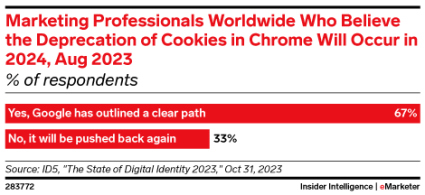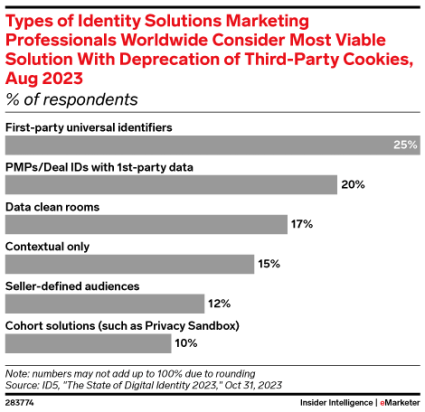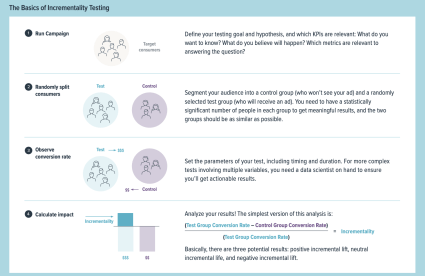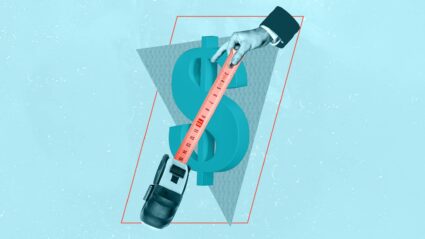Deanna Cullen, Victor Diaz, Maarten Lefor, and Vicki Lopez contributed to this post.
Third-party cookies have officially started phasing out of Google Chrome. Even if Google has delayed the official end game of full deprecation, it’s time for brands to start preparing now for when cookies are gone.
As of this week, Google Chrome is rolling out its Tracking Protection browser feature, which will cut off third-party cookies. 1% of randomly selected Chrome browsers will exclude third-party cookies for ad targeting and measurement.
We don’t expect this first wave to have a major impact on marketing in the short term, but that doesn’t mean advertisers are off the hook. If you’ve been in denial about the imminent arrival of the post-cookie era, it’s really coming for us this time–and fast. If you haven’t already, your team should start preparing for the loss of third-party data right now.

Source: eMarketer
This week in Google Chrome: what the initial phase of cookie deprecation means for your business
So what do the updates to Chrome mean for your marketing today? Not much.
Remember that the 1% cookie holdout will only affect Google Chrome, which–although it was used by 63.6% of internet users worldwide between July and August 2023, according to Statista–is only one piece of the pie when it comes to browsing behavior.
That 1% won’t be as noticeable as you might think, and it won’t be a representative sample of your customers, especially since some people are already using ad blockers. You won’t see a 1% decline in attribution from this change, and the update will never cause an impact like a decline in sales; even if attribution is blinded, sales will still be happening.
Marketers won’t see a major impact right away, since third-party cookies aren’t expected to be fully deprecated in Chrome browsers until 2025. Even then, many types of advertising will be unaffected: social platforms already leverage first-party, logged-in data for targeting, and many advertisers have already built the data pipes through CAPI and the server-side integrations they need for measurement based on first-party data in these environments.
Programmatic media campaigns will be hit the hardest. But programmatic marketers have already been making do without cookies on mobile, connected TV (CTV), and Apple devices. That means advertisers can take advantage of existing solutions that don’t require users to be logged in to work.
Next steps for marketers: how to prepare for the post-cookie world
While there’s no need to panic about cookie deprecation, you do need to get ready. 2024 will be a hard year for marketers who haven’t put in the effort to transition to first-party data.
Here are some steps you can take today to keep your brand ahead of the curve once we lose third-party cookies once and for all:
1. Get consent from your audiences
As first-party data becomes even more essential, make sure you have systems in place so customers can consent to using their first-party data. By now, you should already have a consent management system in place integrated into your data pipelines.
To make your first-party data strategy more effective, your team should also invest in creative solutions to get customers to share their data, including interactive content like quizzes, product finders, or surveys that require the user to give their email address or phone number to engage. On a longer-term basis, you can get reliable first-party information from customers you’ve built a relationship with through loyalty programs, promotions, or VIP experiences.
2. Build or refine your data pipeline
You’ll need to build a durable data infrastructure with robust sitewide tagging to ensure you are capturing the right data across every channel. Once the infrastructure is built, start to move your first-party data around for targeting and measurement purposes. This means sending first-party data to platforms for targeting (and retargeting) and matching against ad exposures for measurement.
These data pipes can take different forms, including CAPI, Enhanced Conversions, Offline Conversions, CDPs, Google Tag Manager server-side, and LiveRamp integrations. You can also consider partnering with platforms like Blotout , which provides data pipes that capture server-side signals and first-party cookies to forward back to ad platforms, extending the life of retargeting and enhancing measurement.
3. Test new tools to help with data collection and management
New technologies are popping up to help marketers overcome the targeting and measurement challenges we’re facing. Now is your chance to test, test, and test again to find solutions that work for your brand before cookies are gone in Q3.
Some major tools you should be experimenting with include:
- Google Ads Data Manager: Google recently launched Google Ads Data Manager as a way to manage and port first-party data into the Google ecosystem. Test the new interface by connecting some of your data sources to see if this integrated option will help your team.
- Google’s Privacy Sandbox: Google is building out the Privacy Sandbox to include products like PAIR for retargeting and Topics API for broad interest-based targeting in programmatic ads. Your team should try out these solutions in your DSP against your current audiences built with third-party cookies.
- Leverage Reverse ETL: Use tools like Hightouch or Census to automate sending first-party data back into ad platforms to improve audience targeting, and enhanced tracking of offline conversions
- Unified ID 2.0: If you’re looking for another option, The Trade Desk is also spearheading a framework with Unified ID 2.0 based on sharing anonymized identity among publishers. Test the performance of these audiences against your current audiences.
You should also be building relationships with third-party data providers that operate in a cookieless environment. These partners will help you access valuable audience insights without relying on traditional tracking mechanisms. By leveraging alternative identifiers such as universal IDs, contextual signals, IFA IDs, and more, you can maintain precise targeting and ensure campaigns reach the right audience segments effectively across the programmatic ecosystem.

Source: eMarketer
4. Bring in more privacy-resilient solutions
As we head into 2024, lean into privacy-resilient solutions such as incrementality testing and media mix modeling, which don’t rely on cookies and can provide a more accurate view of performance over attribution.

Source: AppsFlyer
You should be leveraging advanced household-level graphs for performance media that enhance areas where there may be signal loss and brand lift integrations to track brand sentiment appropriately. These days consumers are using a variety of platforms, from mobile apps to CTV, that do not rely on cookies.
You should also implement data clean rooms so you can measure customer journeys in logged-in environments. They can generate helpful insights that will improve your media strategy, like time to conversion, frequency capping, reach overlap, and more. Multiple platforms also let brands match their own first-party data with clicks, ad exposures, and engagements measured in the platforms, like Google’s Ads Data Hub, Meta’s Advanced Analytics, Amazon Marketing Cloud, and more.
The cookieless future might just be better for your brand
Every brand’s path to a measurement future without cookies will be different, depending on the data you’re currently collecting, your brand’s category, and your business goals. No matter what, you should be thinking outside the box of the data systems you’ve used in the past and looking for better solutions.
Keep in mind that tracking ad exposures on the open web using third-party cookies was never a perfect system for measurement. Assigning attribution through cookies may have been easier than collecting first-party data, but it meant overlooking the impact of TV, radio, OHH, and other channels.
While it’s a big change, the loss of third-party measurement isn’t all bad: it gives advertisers the opportunity to improve data collection so it’s more accurate, more reliable, and more inclusive of all channels. So if you haven’t started working on your post-cookie solutions, it’s time to start today–so you can ensure your brand’s future looks bright.








Responses